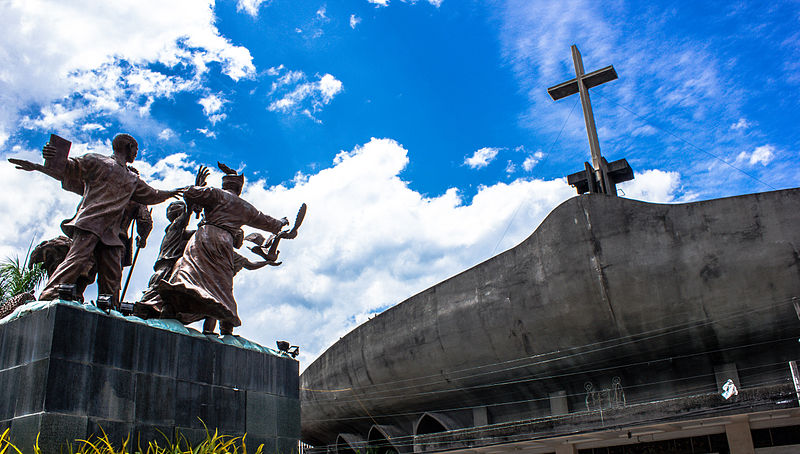 The Commemorative monument of Peace and unity fronting San Pedro Cathedral in Davao City (Photo Source: Wikipedia)
The Commemorative monument of Peace and unity fronting San Pedro Cathedral in Davao City (Photo Source: Wikipedia)
Remembering God’s Frontiersmen

The Commemorative monument of Peace and unity fronting San Pedro Cathedral in Davao City (Photo Source: Wikipedia)
THE introduction and early development of Christianity in Mindanao is associated with the work of early missionaries, predominantly by a small band of Spanish Jesuit missionaries in the 16th century.
Christianity was introduced in Mindanao as early as 1531, Fr. Jose Arcilla, S.J., in his article, “Cross and Crescent” noted that it wasn’t the Spaniard missionaries who brought it to Mindanao but by a certain priest, Francisco de Castro who came from Moluccas (Indonesia) who baptized Datu Elian of Butuan and his people.
Subsequently, Jesuit priest, Frs. Valerio de Ledesma and Manuel Martinez arrived in Butuan in 1586 and started catechism using the local music of the place. “The night air in Butuan echoed with religious songs (Fr. Ledesma) had composed,” wrote Fr. Arcilla. In Butuan, the Jesuits built the first Catholic Church in Mindanao in 1597. Earlier in 1595, some of the Jesuit missionaries were part of the Rodriguez Figuerora expedition to Maguindanao.
In the early part of 17th century, Jesuit missions of Zamboanga in southwest, of Dapitan in northwest, and Iligan in northern Mindanao were established. In the course of this missionary work, some of the Jesuits missionaries were martyred: Frs. Juan de las Misas, Juan del Carpio, Francisco Mendoza, Giovani Aressu, Francesco Palliola, Juan del Campo and Alejandro Lopez.
In 1768, the Jesuits were expelled from Mindanao as a result of anti-Jesuit intrigues in Spain, France and Portugal leading to worldwide suppression by Pope Clement XIV in 1773. The existing Jesuit missions were taken over by other missionaries such as Augustinian Recollects and Dominican Orders. Nineteen years later, Pope Pius XII restored the Jesuit order and allowed them to continue their work of evangelization. The newly returned Jesuits to the Philippines in the middle part of the 19th century was primarily directed to Mindanao.
The first mission was established among the Teduray tribe in the hills of Tamontaca (Cotabato), the Muslim tribes along the riverbank of Rio Grande de Mindanao (Pulangi River bordered by Bukidnon, Misamis provinces). By the end of 19th century, the Jesuits had taken over all the mission posts of Mindanao and Sulu. They were involved in building parishes, pastoral work, and catechetical ministry. They were also pioneering in the compilation of the first dictionaries, wrote the first grammars in Maguindanao, Teduray and Bagobo.
The Jesuit mission in Davao began in June 1, 1868 with a pioneer Jesuit group of Frs. Ramon Barua, Ramon Pamies, and Brother Antonio Gairolas, a lay brother. The Davao mission was marked by a systematic and concerted effort of evangelization among the various tribes to live in settlements, thus easily reached for instructions in Christian precepts and practices.
By the 1890s, even the Muslims were starting to become Christian converts, through the efforts of their own datus, Datu Timan and Datu Porkan, although many others remained steadfast in their own faith to Islam, Fr. Saturnino Urios, S.J. who labored among the Muslims in Davao Oriental and Surigao in 1892 further swayed the latter’s faith that led to the splitting of their population. Muslims who converted to Christianity lived among the Christians in Tigatto, Mawab, and Agdao, under the supervision of Don Francisco Bangoy and Don Teodoro Palma Gil, Sr. respectively.
Towards the end of the 19th century and early 20th century, other missionaries, such as PME, Maryknoll, came and took over some of the Jesuit missions due to the consecration of the scarce Jesuit personnel to Zamboanga mission covering much of the Zamboanga peninsula and Sulu. However, individual Jesuit priest and small groups of Jesuits were still engaged until the present in other areas where Christianity was nascent and remote, especially among the indigenous communities, in the hills and mountains of Mindanao peripheries such as Bukidnon.
At present, Jesuits are involved in seminary formation (St. Vianney seminary in Cagayan), environmental and indigenous rights advocacy, parish and pastoral work (Bukidnon) and, largely, in schools (Ateneo system).
Ateneo de Davao University is the remaining Jesuit institution in Davao Region. It is a continuation of the Jesuit missionary work in Mindanao through such works and service in education, research and community engagement. According to Fr. Joel Tabora, S.J., president of Ateneo de Davao, “it is firmly rooted in the faith, out of which is bases its abiding concern for the poor, its concern for the environment, and its dialogue with diverse culture and religions.”
Looking back, the Jesuits and other missionaries who came and started sowing the seeds and nurturing the early growth of Christian faith among the lumads of Mindanao were motivated by the zeal and devotion to the mission of evangelization. The audacity and almost heroic work they had done reflect the gracious hand of the Lord who moved these missionaries to unimaginable sacrifice of life for the sake of the Gospel. Today, a vibrant and robust faith that characterize the Church of Mindanao and its increasing missionary activities in Asia continues to trace its origins and find inspiration from the mission of these God’s early frontiersmen. (Fr. Archimedes A. Lachia, S.J.)
REFERENCES:
Jose Arcilla, S.J. “Return of the Jesuits” in Philippine Studies Vol. 26, Nos. 1 and 2 (1978) 16-34.
Roberto Salva. “Divine Timing” in Jesuits in Mindanao: The Mission (Media Wise Foundation).
Joel Tabora, S.J. “Recalling the Jesuits in Mindanao History” in https://taborasj.wordpress.com/2015/01/10/recalling-the-jesuits-in-mindanao-history/


No Comments